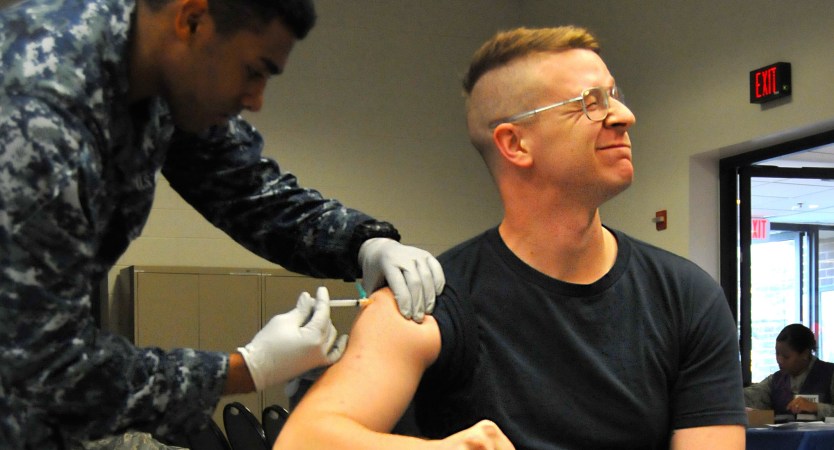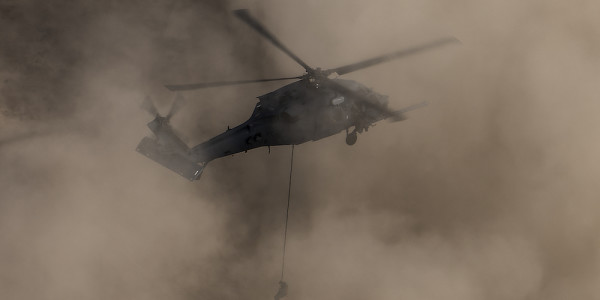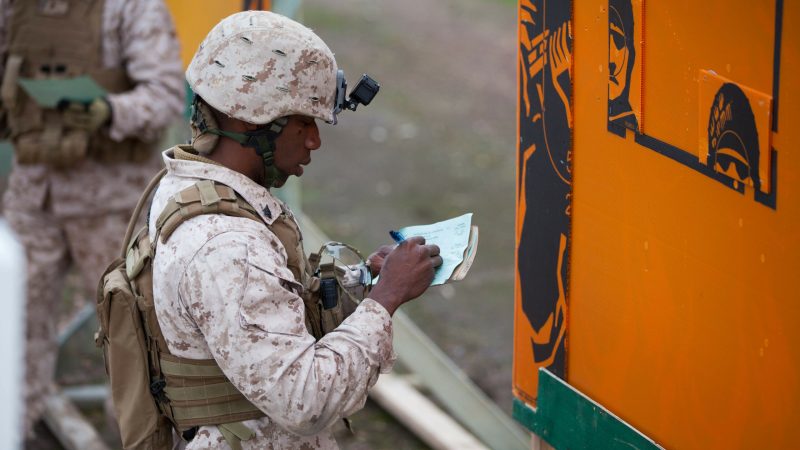The saying goes that practice makes perfect, and Air Force helicopter pilots just got some high-quality practice against an enemy they have a good chance of meeting on the battlefield should the U.S. fight a war with Russia, North Korea or other countries that fly one of the world’s most famous combat helicopters: the Mi-24 Hind.
Aviators with the Air Force’s 41st Rescue Squadron flew from their home at Moody Air Force Base, Georgia out to Lancaster, Texas late last month to find out how to fly against the Hind in a rare match-up that was meant to prepare crews for picking up downed pilots or other friendly troops in a conflict where air superiority is not guaranteed. Though Air Force helicopter crews often train against aviators flying American helicopters and fixed-wing aircraft, they don’t often get to fly against the same aircraft they might fight in a future war.
“This training is part of a building block approach for our aircrew to conduct personnel recovery in a major combat operation (MCO) environment,” Lt. Christian Little, a spokesperson for Moody-based 23rd Wing, told Task & Purpose. “Air combat maneuvering is the capstone event in the air-to-air training block and helps reinforce the concepts of energy maneuverability, crew resource management, survivability, and mutual support.”
With its tandem cockpit, weapon-loaded wings, large troop bay and menacing appearance, the Hind is the battle wagon of choice for action movie bad guys from Rambo III to Top Gun: Maverick. They have good taste: the helicopter is fast, tough and can carry an armory’s worth of weapons for the protagonist to dodge. So how do American helicopter crews fight something like that?
“We were able to come out here and fight against an actual threat helicopter, “ said Maj. Matthew Keough, a pilot with the 41st Rescue Squadron, in a video posted to Facebook by Moody Air Force Base last week. “So we get an accurate representation both visually and aerodynamically of the threat helicopter that we can’t get anywhere else.”
Knowing is half the battle, but Hind helicopters are not an everyday sight for most U.S. troops. Despite the helicopter being widespread in militaries around the world, only a few exist in America, Keough explained. U.S. aviators can study the performance of a Hind in a book all they want, but there’s nothing quite like watching one come at you in real life.
“If we find ourselves in a theater that has a bunch of Hinds, and Hinds are very prolific throughout the world, this will better prepare us,” Keough said. “We get to fly the real thing, we get to see the real capabilities and real limits of the aircraft.”
Little said the exercise was an opportunity to practice air combat maneuvering, which “is one of the best ways our aircrew learns how a potential threat helicopter flies and how HH-60W aircrews can defend themselves against an opposing force’s aircraft.”
Subscribe to Task & Purpose Today. Get the latest in military news, entertainment, and gear in your inbox daily.
Though Moody helicopter crews occasionally perform air combat maneuver training with fixed-wing fighters and Marine and Army helicopters, Little explained, this was a rare chance to fly against the type of helicopter that might actually be pointing weapons at them in a future fight.
The Air Force has put on similar exercises against Mi-24s in the past. For example, in 2019 pilots from the 55th Rescue Squadron based in Davis-Monthan Air Force Base, Arizona, practiced flying against the gunships in their HH-60G Pave Hawks. The Pave Hawks are a variant of the Army Black Hawk helicopter that is specifically tasked with combat search and rescue and personnel recovery missions. However, the recent exercise with the Moody-based 41st Rescue Squadron is the first time the new HH-60W Jolly Green II has faced off against the so-called ‘Flying Tank.’

With a longer range and better sensors, the 60W is the replacement for the 60G, though a recent decision by the Air Force to cut back on buying the new helicopter has raised eyebrows across the search and rescue community. The Air Force will still buy 75 60Ws in total though, and those pilots may face Hinds someday.
“The HH-60W has never been put into this kind of scenario before,” said Capt. Tyler Hudson, another pilot with the 41st Rescue Squadron. “This is the first time that we’re testing the Whiskey out against an adversary like this, against the Hind, so it’s really proving our techniques and the way that we’re able to employ the Whiskey and getting us one step closer to be comfortable taking it into combat.”
How do Black Hawk variants like the Jolly Green II compare to the Mi-24? Hudson and Keough explained that the Hind is bigger, heavier and moves faster than the 60W. But what the 60W lacks in straight-forward speed it makes up for in maneuverability.
“From an agility standpoint, Western helicopters have an advantage,” John Totty, a Hind instructor pilot, said in a 2018 article for Vertical Magazine. “A turning fight is not where the Hind pilot wants to be.”
It might not turn so sharp, but the Hind is tough and has plenty of bite, including a 12.7mm machine gun beneath its chin and a range of rockets, bombs and guns that can be mounted to its wings or fired from the troop bay. Still, Jeff Nolan, a former Navy helicopter pilot, pointed out that helicopters like the Hind are often used for air-to-ground attack missions, not air-to-air combat against other helicopters.
With the prevalence of portable surface-to-air missile systems and other anti-air threats, helicopter crews may be more likely to face threats from the ground than from fellow helicopters, Nolan pointed out. That’s evident in the Russian invasion of Ukraine, where as of last month Russia has reportedly lost nearly 200 helicopters to enemy fire, according to Business Insider.

Change may be in the works, though. As the U.S. military prepares to fight China or Russia in a possible future conflict, the Air Force combat rescue community is planning out how to rescue downed pilots or other friendly forces in coordination with its fixed-wing cousins in the rest of the Combat Air Force, many of whom can destroy enemy tanks, suppress enemy air defenses and chase away enemy fighters to clear the air space for a successful rescue mission.
“I’m of the opinion that what the 41st Rescue Squadron is doing is spot on and ideal given the task and purpose of Combat Air Force vertical lift,” said Lt. Col. Brough McDonald, an Air Force combat search and rescue helicopter pilot.
McDonald explained that combat Air Force helicopter crews must be prepared to fly in scenarios where air superiority may not be guaranteed, and that includes threats from enemy helicopters or fixed-wing aircraft. While Air Force combat rescue squadrons routinely fly against friendly fixed-wing aircraft pretending to be enemies, “the opportunity to fly against aggressor helicopters is more rare, and when the opportunity presents itself, should be taken,” McDonald said.
McDonald cited an example of a real-life Air Force combat search and rescue mission in the recently-released movie Top Gun: Maverick. Not to spoil anything, but a certain famous pilot has to bail out over enemy territory, where he is almost immediately confronted by an enemy Mi-24 helicopter. At around the same time, an American naval officer overseeing the mission suggests sending in ‘CSAR’ to rescue the downed U.S. pilot.
“This is my moment!” McDonald recalled thinking while watching the movie. Then, about the Hind, “I can fight that!”

Unfortunately for McDonald, the admiral in charge of the operation depicted in the movie opted not to send in CSAR, but McDonald and his pilot colleagues are training for the moment when an admiral or other higher-up chooses differently. So how exactly does one go about battling a Hind? While it’s true most helicopters don’t carry air-to-air weapons, there’s nothing stopping China or Russia from trying it in the future, McDonald said. Also, in a world where American F-15E Strike Eagle fighter pilots once dropped an air-to-ground bomb on an Iraqi helicopter, and where Ukrainian soldiers are reportedly shooting down Russian helicopters with anti-tank missiles, who’s to say American or enemy helicopter crews can’t adapt an air-to-ground weapon to try to shoot down another helicopter?
“We have our crew-served weapons, and while they’re not optimized for air-to-air, if it generates the effect of a Hind turning its nose and going away, approved,” McDonald said.
Lt. Little, the Moody spokesperson, said the Jolly Green II could fly with and operate the GAU-2 minigun and the GAU-21 .50 caliber weapons systems, which Moody crews train to use against enemy helicopters in air combat maneuver training. When the fight’s on, the air combat maneuvers used between two helicopters over Texas last month were comparable to the basic fighter maneuvers American fighter pilots use when battling each other, albeit at much slower speeds and much lower to the ground, McDonald explained. The helicopter pilot recalled a moment of training with an F-15 Eagle pilot in the backseat and the fighter jockey said “you’re doing the same thing we’re doing but a bit slower.”

Another advantage of the exercise against the Hinds is that a few Moody pilots got to sit in the Mi-24s and see the fight unfold from the adversary’s cockpit, Little explained. Contractor pilots flying the Hinds briefed the Moody airmen on the aircraft’s weapons systems, and the students then carried that knowledge with them into the weapons system seat the next day while the contract pilot flew the Hind.
“Having Moody AFB aircrew in both aircraft enabled the crews to practice defending against a threat and analyze how effective those tactics are from an opposing force perspective,” Little said.
Those same skills apply to fighting fixed-wing aircraft. While a match-up between helicopters and fixed-wing aircraft might seem one-sided in favor of the latter, McDonald explained that helicopter crews can hug the earth and fly tight turns to frustrate the enemy pilot’s efforts to get a missile lock. The goal is to survive for several minutes until friendly fixed-wing aircraft can swoop in and scare off the adversary, McDonald explained.
Whether the match-up is against enemy helicopters or fixed-wing aircraft, one lesson air crews took away from the Hind exercise helps in any situation: how to react and communicate when Plan A goes down the toilet.
“It’s very easy during normal training sorties to do this choreographed, pre-briefed, scripted kind of thing,” Keough said. “It’s much more difficult when you add in that third player or, in this case, a Hind.”

When a Hind or any threat appears, Air Force crews must react swiftly to defeat or escape it, even if it means working outside the usual chain of command. Nolan explained that helicopter missions will have pre-designated mission leads, but if a sudden threat or other emergency occurs, another member of the flight crew can take tactical lead, also called tac-lead, to direct the rest of the flight out of harm’s way. It could be a command as simple as ‘break left’ or ‘break right,’ but it could be what makes the difference, and the Air Force crews seemed to be practicing it in earnest.
“Everyone in the formation … at any point in time, they can take what’s called ‘tac-lead,’ and they can direct a call that may be what saves the formation,” Keough said. “So this training is an opportunity to really bolster people’s confidence and let them know when they need to speak up, take that tac-lead, make a directed call, that could be the difference between the formation coming back or not.”
That kind of skill set applies across military helicopter life, whether the threat is a Hind or a missile.
“All they’re doing is training to open up the envelope for the what-if,” Nolan said. “They’re training their crews to be more nimble again.”
The latest on Task & Purpose
- Navy fires nuclear submarine captain after only 8 months on the job
- Which Marine Corps boot camp is tougher? This Marine experienced both
- Air Force relieves medical squadron commander after barely a year on the job
- Airmen acted on ‘gut feeling’ when they rescued 8 people from a circling bull shark
- The Army may ditch alcohol restrictions for soldiers in the barracks
Want to write for Task & Purpose? Click here. Or check out the latest stories on our homepage.

























